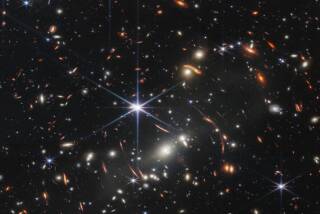National Perspective : Fixing the Troubled Hubble
- Share via
The orbiting Hubble Space Telescope was launched in 1990 with a flawed main mirror; it has difficulty focusing on nearby objects and cannot see the deepest reaches of space. NASA is preparing to install corrective optics this week during five spacewalks, the space agency’s most difficult and ambitious mission in decades.
GETTING READY: The space telescope was designed to be serviced in space, but a repair job of this magnitude will require many delicate steps:
1) Space shuttle will be launched Wednesday from Kennedy Space Center in Florida and maneuver into the telescope’s orbit.
2) As the shuttle approaches, telescope controllers at the Goddard Space Flight Center in Greenbelt, Md., will close the telescope’s aperture door, roll up its solar panels and stow its antennas to protect them from damage.
3) Shuttle controllers at the Johnson Space Center in Houston will inch the shuttle close to the telescope, taking care not to contaminate the telescope with rocket thruster exhaust.
4) A shuttle crew member will use the shuttle’s remote manipulator arm to grab the telescope and lower it onto a special holder in the shuttle’s cargo bay.
*
THE DESIGN: Reflecting telescopes like the Hubble magnify starlight with mirrors instead of lenses. In the Hubble, a 94-inch-wide main mirror concentrates light and bounces it off a secondary mirror to cameras and other sensors. The main mirror was designed to concentrate light to a single point, letting astronomers see dim and distant stars.
THE PROBLEM: A manufacturing error produced a flaw in the main mirror. The outer edge is too flat--by 1/50th the width of a human hair--so it concentrates light 1.5 inches behind light from the center of the mirror. Thus, part of the picture is always out of focus.
THE SOLUTION: Scientists want to use “corrector mirrors” to sharpen the Hubble’s vision. Astronauts will try to install a pair of instruments fitted with nickel-sized corrector mirrors that should bend all the light rays back into a single focus.
*
SPACEWALK SCHEDULE: Six-hour spacewalks are scheduled for five consecutive days
DAY 1: The first team of two astronauts will set up tools in the cargo bay, then replace two faulty gyroscopes.
DAY 2: A second team of two astronauts will replace the wobbly solar-energy panels.
DAY 3: The first team will replace the “wide-field and planetary camera” with a new version equipped with corrective optics, then replace two guidance controls.
DAY 4: The second team will install new electronics and the “corrective optics space telescope axial replacement” or “COSTAR,” a box full of remote-controlled mirrors designed to restore perfect vision to all other on-board cameras.
Source: NASA
More to Read
Sign up for Essential California
The most important California stories and recommendations in your inbox every morning.
You may occasionally receive promotional content from the Los Angeles Times.










